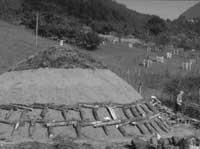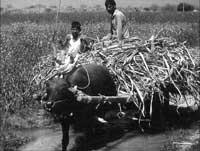Biomass, renewable organic fuel
2000/11/26 Carton Virto, Eider - Elhuyar Zientzia
Not so long ago, the txondorras of charcoal could be seen in the forests of Euskal Herria. In fact, charcoal has been and continues to be an important fuel for many centuries. But when fossil fuels predominated during the time of the Industrial Revolution, biomass was discarded, at least in the industrialized countries, and it is not that many more years have been reinforced.
Multi-purpose source
With the end of fossil fuels and the warming of the planet, alternative energy sources are increasingly protected. It is believed that renewable energies will play an important role in the future and biomass has great possibilities to get ahead of renewables. It has advantages that other sources do not have.
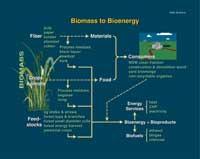
Solar energy and wind energy, to quote two that are in everyone's mouth, have limitations in terms of the energy they generate: they can produce mechanical energy, electricity and heat, but no more. Biomass, however, serves to produce heat and electricity, but from biomass can be derived burning or liquid gas that will be stored in tanks and obtained by pumps. Biomass can become solid fuel, liquid or gaseous and, from small impositions, it can replace fossil fuels in the future. According to some studies, biomass for the year 2050 will be the fifth part of electricity and the source of two fifth of direct fuel, especially in industrialized countries, such as the ACBC, biomass represents 78% of renewable energy in the Strategic Plan 2005.
Solar origin
The energy of biomass is basically the chemical energy, accumulated by the compounds present in the living tissues. The ultimate origin of all these compounds is the photosynthesis that occurs in plants. During photosynthesis, the plants convert solar energy into organic matter. Subsequently, the animal kingdom, including man, acquires and transforms organic matter. Although the performance of the photosynthesis process is very low, the large plant surface that covers the Earth is a great source of energy.
Biomass, coming from animals or plants, changes its characteristics. Since biomass from plants contains more carbohydrates, these are energy efficient, so plant biomass is the most useful to produce energy. Animal biomass, on the other hand, is less suitable for energy production.
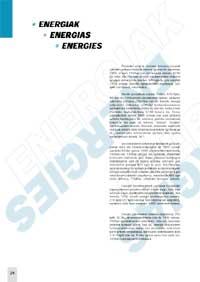
Currently the production and use of biomass has been developed mainly in two areas: residual biomass and energy production crops. The residues can be both of natural origin and of human activities. Forest scrub or fallen trees are natural waste and very suitable for energy production, since only in areas where energy demand is very low can the forest be systematically exploited. In fact, forests are currently being lost in many regions of the planet. For this reason, the most appropriate is to take advantage of the waste of waste and waste, as well as the waste of the timber industry. Of these residues, more energy of the estimate can be extracted.
Waste generated in the forestry, agricultural, livestock, industrial or organic waste and urban waste sectors also serve to produce biomass energy. In many cases they are used for the production of biogas and biogas, mainly composed of methane, can be burned to produce electricity. In the Autonomous Community of the Basque Country there are three plants that produce electricity from garbage. Bio Artigas de Bizkaia, Bio SanMarcos de Gipuzkoa and BioSasieta de Goierri, inaugurated this year.
Energy Agriculture Energy Agriculture
The crops for the production of energy are crops destined exclusively to the obtaining of energy. In countries like Brazil and the United States, sugarcane and corn are exploited to obtain ethanol used as fuel for cars. Ethanol is mixed with the gasoline of the cars, which allows to prepare gasoline without lead. As a biomass fuel, fast-growing trees, cereals and vegetable oils are generally used. Its cultivation is an excellent way of recovery of degraded soils and its added value lies in the use of plants to produce energy.
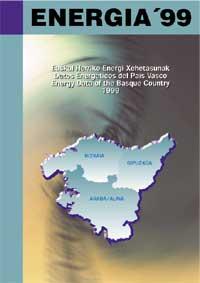
However, there are many discussions about energy production crops. Profitability and competition with food. Food, of course, is a priority, so cultivation for the production of biomass energy should be properly analyzed to avoid food competition. In some municipalities, instead of using waste, the temptation to prepare specific crop fields to generate energy can mean not only a lower nutrient growth, but also the disproportionate cutting of forests to cultivate new fields. However, there are cases in which joint production of food and energy is an advantage, since when infrastructures and the economic situation improve, food production increases.
The cultivation of some agricultural or forestry species for obtaining energy is very appropriate for the balance of environmental carbon dioxide and for improving the state of nature. The carbon dioxide emitted by burning the biomass is reabsorbed by the crops, so that the carbon dioxide balance is empty.
There is technology for the use of biomass, but prices are the main limits. The price of oil, which now seems impressive, is false, does not take into account the entire cycle and therefore biomass is more expensive. But it is not real. Cleaning a stained atmosphere with fossil fuels is much more expensive than marketing biofuels.
Opportunity for people in development
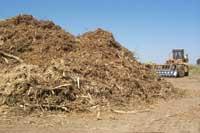
An energy system based on biomass not only benefits the environment, but it can help the underdeveloped countries get out of the hole. This is a way of creating employment, since the production of biomass requires a great labor force. For this reason, they consider that the underdeveloped countries, including the United Nations Food and Agriculture Organization (FAO), are a good way to develop rural areas. The production, transformation and commercialization of biomass generates many more jobs than other energy activities and requires at the same time a lower investment, both in the beginning and in all other steps.
Biomass can cause energy decentralization and bring electricity and water to non-industrialized agricultural areas. On the other hand, the by-products that are generated in the transformation of biomass serve to promote the agricultural economies of those regions: they can be used for the burning of bushes and branches and for the obtaining of heat; if there are residues they are good as fertilizer and be food for animals.
Published in the supplement Natura de Gara

Gai honi buruzko eduki gehiago
Elhuyarrek garatutako teknologia




